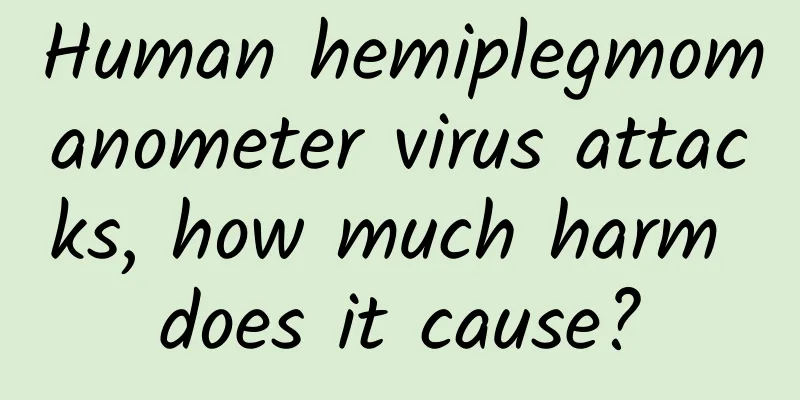Human hemiplegmomanometer virus attacks, how much harm does it cause?

|
Author: Li Chunhong Unit: Zhanjiang Fourth People's Hospital Human metapneumovirus is a common virus that can cause acute respiratory infections. It belongs to the Pneumoviridae family, the Metapneumovirus genus, and is an enveloped single-stranded negative-strand RNA virus. The average diameter of the virus particle is about 200nm, including two genotypes, A and B, which can be further divided into four subtypes, A1, A2, B1, and B2. These subtypes often prevalent at the same time, and there is no significant difference in the transmissibility and pathogenicity of each subtype of the virus. The following is a detailed introduction to the popular science knowledge of human metapneumovirus: 1. Transmission channels Human metapneumovirus is mainly transmitted through droplets and contact. Droplet transmission means that the droplets released by an infected person when coughing or sneezing contain the virus, and others may be infected after inhaling these droplets. Contact transmission refers to close contact with an infected person or objects contaminated by the virus, and then touching one's own body parts, causing the virus to enter the body. 2. Susceptible population: The entire population is susceptible, but the severity of symptoms varies from person to person. Children under 5 years old, the elderly, and people with weakened immune systems may experience more severe symptoms after infection. 3. Clinical manifestations Common symptoms: After being infected with human metapneumovirus, symptoms of upper respiratory tract infection such as fever, cough, nasal congestion, runny nose, and hoarseness are often manifested. 4. According to the course of the disease, it can be divided into the following types: 1. Asymptomatic period: occurs within a few days after viral infection, that is, the incubation period, usually 3 to 6 days. 2. Upper respiratory tract infection symptom period: lasts about 1 week. This period is mainly clinically diagnosed as nasopharyngitis and laryngitis. 3. Remission period: For mild cases, it is often self-limiting, that is, the symptoms will be relieved after a period of time. 4. Lower respiratory tract involvement period (severe disease): For high-risk groups, such as children, the elderly and those with weakened immune function, severe lower respiratory tract infections such as bronchiolitis and severe pneumonia may occur. 5. Diagnostic Methods The virus RNA in respiratory secretions is mainly detected by fluorescence quantitative PCR, viral gene sequencing and other methods. In addition, serological tests and imaging examinations can also assist in diagnosis. 6. Treatment Methods Currently, there is no specific antiviral drug available for the treatment of human metapneumovirus infection. Treatment measures are mainly symptomatic supportive treatment, such as antitussive, antiasthmatic, and antipyretic. 7. Preventive measures: 1. Develop good hygiene habits, such as washing hands frequently and wearing masks. 2. Open windows regularly every day to ventilate and keep the indoor air unobstructed. 3. Avoid close contact with infected people or objects contaminated by the virus. 4. For high-risk groups, such as children, the elderly and those with weakened immune systems, they should pay close attention to changes in their condition and seek medical attention promptly if respiratory symptoms occur. Human metapneumovirus is a prevalent respiratory virus that is common in the entire population. Although there is currently no specific vaccine or antiviral drug available to prevent and treat infection with this virus, the risk of infection can be effectively reduced by taking preventive measures such as adopting good hygiene habits, keeping indoor air clean, and avoiding close contact with infected people. |
<<: The secrets to a healthy heart: Five strategies that start with your diet
Recommend
Does the dragon blood tree need organic fertilizer? When should the dragon blood tree be repotted?
Dracaena is a very ornamental green plant. Many f...
Large-scale "encounter" with Omicron - Focus on the six major focuses of the Tianjin epidemic
Following Shaanxi and Henan, Tianjin has become a...
Hysterectomy surgery steps
Women need to protect their bodies comprehensivel...
What to eat for irregular menstruation, 3 delicious foods to regulate
Irregular menstruation not only harms health, but...
What to eat is good for your ovaries
After a woman reaches the age of 40, her body fun...
What causes premature end of menstruation?
Premature end of menstruation is also a common me...
Can I have sex 13 days after having an IUD inserted?
Regular sexual intercourse after marriage can not...
How to grow the Schefflera chinensis to make it flourish? What should be paid attention to when growing Schefflera chinensis?
Schefflera is very common in our daily life. Beca...
What is the reason for 2 plus signs in urine sugar during pregnancy?
Pregnant women need to pay attention to many thin...
Can Begonia be placed indoors? What are the methods for growing Begonia?
Begonia is also known as "national beauty&qu...
How to treat vulvar itching?
Vulvar itching in women is a very common abnormal...
What should I do if my hcg value is low?
Women in the early stages of pregnancy need to go...
What should boys who have just started dating do? What should boys who have just started dating pay attention to?
We all know that when it comes to dating, many bo...









